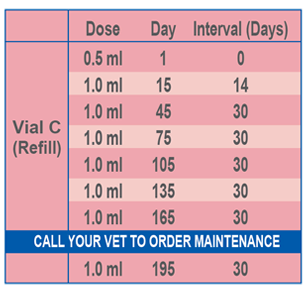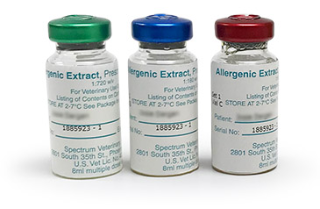Nextmune Allergy Test & Treatment Service
Treatment Set
Injection Treatment
How Effective Is This Treatment?
How To Administer Treatment
Step 1
Upon arrival, please refrigerate and store upright at 35-44°F(2-7°C).
Step 2
Bring allergens to room temperature when ready to inject treatment.
Step 3
Holding vial upside down, draw correct dosage in syringe. Ensure no bubbles are present. If they appear, flick the syringe and press to release bubbles. Lift back of patient’s neck creating a “tent”. Insert needle at tent base, below the skin’s surface. Withdraw plunger slightly, if no blood present, inject allergens.
Step 4
Massage the injection site. Praise the patient. Return vial to refrigerator. Always monitor for 45 minutes as a precaution
Injection Dosage Schedule
Initial Treatment
3 vials (green, blue, red) of increasing concentrations to be administered over a 9 month period using the dosing schedule below

Maintenance Treatment
This maintainace treatment should be started after completion of the inital treatment set. Each vial (red), is at the same concentration as Vial C in the inital treatment set, but is administered over approximately 8 months using the dosing schedule below .

About Injections...
Immunotherapy injections have been used in both human and veterinary medicine for decades with great success.
Pros:
Cons:
Possible reactions with injections:
Reactions can range from mild irritation at the site of injection or local/ generalized hives. Systemic reactions include lethargy, vomiting or diarrhea. Anaphylasis is extremely rare.
Shots are administered over a 9-month period and administered in increasing doses as well as gradual increases in concentration. The 3 vials of increasing concentration are supplied directly by Nextmune on a prescription basis to the testing veterinarian. The initial 9-month period of hyposensitization is followed by monthly maintenance shots.
Sublingual Treatment
How Effective Is This Treatment?
How To Administer Treatment
Step 1
Upon arrival, please refrigerate and store upright at 35-44°F(2-7°C).
lt is not necessary to bring to room temperature.
Remember: NO FOOD/DRINK 30 minutes before or 10 minutes after.
Step 2
Prime the pumper, simply depress the pump several times with short firm bursts until allergen is released consistently.
Step 3
Rest the dispensing arm of the pump on the lower teeth near the front or side of the mouth. Place the tip of the arm over the teeth. To administer, depress the pump fully and quickly so that the correct dosage is released into the mouth (preferably under the tongue.)
Repeat for a total of 2 squirts for pets under 22 lbs (10 kg) or 3 squirts for pets over 22 lbs (10kg).
Sublingual Dosage Schedule
| Patient Weight | Dose |
|---|---|
| Less than 10 kg (22Ibs) | 2 squirts once daily |
| Greater than 10 kg (22Ibs) | 3 squirts once daily |
PLEASE NOTE: Please store upright and refrigerated at 35-44°F (2-7°C)
About Sublingual Immunotherapy ...
Sublingual immunotherapy is a great solution for pet parents who prefer a needle free option and/ or have pets that have had issues tolerating immunotherapy injections in the past. Proper and consistent administration are the key to success with sublingual immunotherapy.
Pros :
Cons:
Possible reactions with sublingual immunotherapy:
Reactions can include puritis, face-rubbing, GI issue, itchy mouth or lethargy. Systemic reactions are extremely rare and undocumented.
Enquiries:
Please contact with your primary veterinarian. Thank you.








